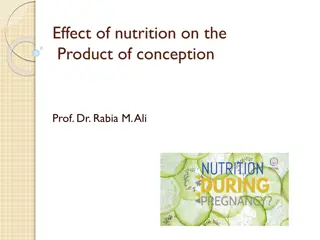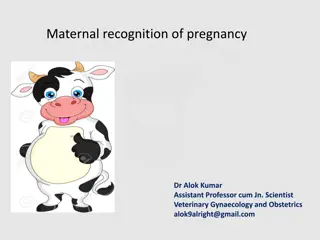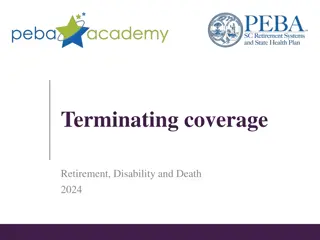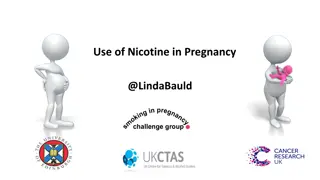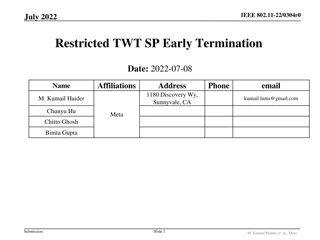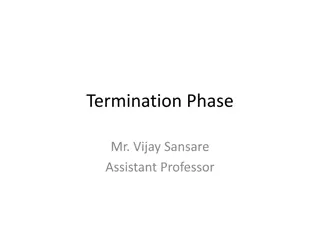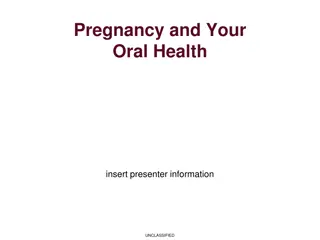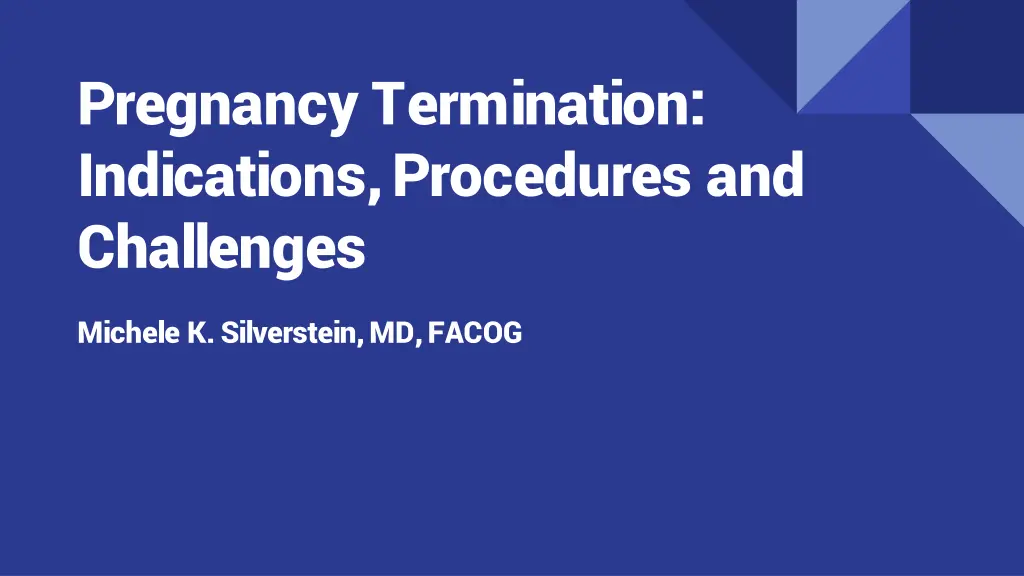
Understanding Pregnancy Termination: Indications, Procedures, and Safety
Explore the indications, methods, and safety aspects of pregnancy termination, including elective, fetal, maternal reasons, and challenges like abnormal placentation and exposure risks. Learn about the safety of legal abortion services and the low maternal mortality rates associated with this essential aspect of maternal health care.
Download Presentation

Please find below an Image/Link to download the presentation.
The content on the website is provided AS IS for your information and personal use only. It may not be sold, licensed, or shared on other websites without obtaining consent from the author. If you encounter any issues during the download, it is possible that the publisher has removed the file from their server.
You are allowed to download the files provided on this website for personal or commercial use, subject to the condition that they are used lawfully. All files are the property of their respective owners.
The content on the website is provided AS IS for your information and personal use only. It may not be sold, licensed, or shared on other websites without obtaining consent from the author.
E N D
Presentation Transcript
Pregnancy Termination: Indications, Procedures and Challenges Michele K. Silverstein, MD, FACOG
Overview 1. Indications for Pregnancy Termination 2. Methods/Choice of Procedure 3. Complications
Abortion The termination of a pregnancy after, accompanied by, resulting in or closely followed by the death of an embryo or fetus. Spontaneous expulsion of a human fetus (i.e. miscarriage) The medical procedure of inducing expulsion of a human fetus to terminate a pregnancy.
Induced abortion is one of the most commonly performed gynecologic procedures in the US <50% done at less than or equal to 8 weeks of gestation 90% done within the first twelve weeks of gestation 1% done after 20 weeks of gestation
Safety From a public health perspective, safe and legal abortion services are a cornerstone of maternal health care The risk of death from abortion at 16 weeks of gestation or less is 5-10 fold less than that of a continuing pregnancy Maternal mortality in the US is approximately 23 per 100,000 live births
Indications for Pregnancy Termination 1. Elective 2. Fetal 3. Maternal 4. Ectopic location of pregnancy
Fetal indications for pregnancy termination 1. Fetal demise at any gestational age 2. Diagnosis of genetic abnormality by chorionic villus sampling (CVS) or amniocentesis -chromosomal -inherited genetic disorders 3. Structural abnormality detected on detailed anatomy ultrasound -i.e. cardiac malformations, anencephaly 3% of all live births affected by a major congenital anomaly
Fetal indications for pregnancy termination (2) 4. Abnormal placentation -placenta previa, accreta, percreta -cesarean scar implantation 5. Concerns for exposure to teratogens -radiation or other environmental concerns -medications
Maternal Indications for Pregnancy Termination 1. Medical Conditions 2. Psychosocial Conditions 3. Cases of rape or incest
Considerations of Maternal Disease and Pregnancy 1. What is the impact of the disease on the pregnancy? 2. What is the impact of pregnancy on the disease, both short and long term? 3. What management would be recommended without pregnancy? 4. Can the change in management be justified? 5. What are the risks/benefits to the mother and fetus and are they aligned or contrary to each other?
Maternal Medical Conditions 1. Cardiovascular Disease 2. Surgically Corrected Structural Heart Disease 3. Chronic Hypertension 4. Diabetes 5. Malignancy 6. Neurologic 7. Psychiatric 8. Surgery
Psychosocial Factors 1. Relationship Issues 2. Other life stressors 3. Financial 4. Impact on the family
Other Indications 1. Elective, no medical or other factors considered 2. Ectopic pregnancy which requires surgery or other medical management
Options/Methods of Pregnancy Termination 1. Choices are gestational age dependent 2. Surgical 3. Medical 4. Expectant (in the cases of fetal demise)
Surgical Methods of Pregnancy Termination 1. Transcervical Evacuation a. Dilatation and Curettage (D&C) b. Dilatation and Evacuation (D&E) 2. Major Operations a. Hysterotomy b. Hysterectomy
Dilatation and Curettage 1. Curettage by vacuum aspiration performed at gestational age of less than or equal to 12 weeks 2. Technique of Menstrual Extraction can be used in the earliest of cases a. Use of a flexible cannula attached to an aspirator or syringe b. Manual Vacuum Aspiration (MVA) c. Generally does not require cervical dilation 3. Electric Vacuum Extraction (EVA) more commonly performed a. Requires cervical dilation b. Use of either local or general anesthesia c. Greater than 6 weeks
Dilatation and Evacuation 1. Term used for cervical dilatation followed by evacuation of the products of conception after 12 weeks 2. Predominant method of termination beyond 12 weeks 3. Requires a greater degree of cervical dilatation which necessitates the use of osmotic dilators for a period of 6-48 hours prior to the procedure 4. Tents of Laminaria Japonica, a natural seaweed are the most commonly used dilators 5. Use of special forceps to remove the larger volumes of tissue 6. Prostaglandins may also be used for cervical ripening.
Major Operations 1. Rarely Performed 2. Hysterotomy -a surgical incision in the uterus by a transabdominal approach, in essence, a cesarean section 3. Hysterectomy 4. Most commonly performed with abnormal placentation or to complete a failed or complicated D&E
Non-surgical Options 1. Medical Abortion 2. Induction of Labor
Medical Abortion 1. May be used up to 63 days of gestation, calculated by the LMP or 9 weeks gestational age by sonogram 2. Most common regimen in the US is mifepristone 200 mg PO followed by buccal administration of 800 mcg of misoprostol 24-48 hours later 3. Usually causes expulsion of the pregnancy within several hours of the misoprostol dose 4. Up to 5% require surgical intervention 5. Increased risk of Clostridial infection 6. Misoprostol is taken in the privacy of one s home
Induction of Labor 1. Termination of Pregnancy by stimulation of labor like contractions that cause eventual expulsion of the fetus 2. Instillation of hypertonic solution of saline or urea into the uterine cavity to cause contractions 3. More commonly, prostaglandins and/or oxytocin are used 4. Gestational age dependent 5. Must be done in a hospital setting
Risks and Complications of Pregnancy Termination 1. Immediate 2. Delayed 3. Late 4. Both medical and surgical methods have risk of complications
Immediate Complications 1. During or within 3 hours of procedure 2. Uterine perforation (3-20/1000) 3. Hemorrhage 4. Cervical injury 5. Anesthetic Complications 6. Amniotic Fluid Embolism
Delayed Complications 1. 3 hours to 28 days post-procedure 2. Infection 3. Hemorrhage 4. Failed procedure, retained products of conception
Late Complications 1. Asherman s Syndrome-Intrauterine Adhesions 2. Cervical Incompetence 3. Psychological Effects a. Guilt b. Depression c. Anxiety
Abortion is never simple, no matter the state, the stage of pregnancy nor the reason.





